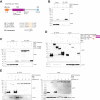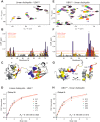Oxygen-dependent asparagine hydroxylation of the ubiquitin-associated (UBA) domain in Cezanne regulates ubiquitin binding
- PMID: 31937588
- PMCID: PMC7039550
- DOI: 10.1074/jbc.RA119.010315
Oxygen-dependent asparagine hydroxylation of the ubiquitin-associated (UBA) domain in Cezanne regulates ubiquitin binding
Abstract
Deubiquitinases (DUBs) are vital for the regulation of ubiquitin signals, and both catalytic activity of and target recruitment by DUBs need to be tightly controlled. Here, we identify asparagine hydroxylation as a novel posttranslational modification involved in the regulation of Cezanne (also known as OTU domain-containing protein 7B (OTUD7B)), a DUB that controls key cellular functions and signaling pathways. We demonstrate that Cezanne is a substrate for factor inhibiting HIF1 (FIH1)- and oxygen-dependent asparagine hydroxylation. We found that FIH1 modifies Asn35 within the uncharacterized N-terminal ubiquitin-associated (UBA)-like domain of Cezanne (UBACez), which lacks conserved UBA domain properties. We show that UBACez binds Lys11-, Lys48-, Lys63-, and Met1-linked ubiquitin chains in vitro, establishing UBACez as a functional ubiquitin-binding domain. Our findings also reveal that the interaction of UBACez with ubiquitin is mediated via a noncanonical surface and that hydroxylation of Asn35 inhibits ubiquitin binding. Recently, it has been suggested that Cezanne recruitment to specific target proteins depends on UBACez Our results indicate that UBACez can indeed fulfill this role as regulatory domain by binding various ubiquitin chain types. They also uncover that this interaction with ubiquitin, and thus with modified substrates, can be modulated by oxygen-dependent asparagine hydroxylation, suggesting that Cezanne is regulated by oxygen levels.
Keywords: Cezanne; FIH1; OTU domain-containing protein 7B (OTUD7B); UBA domain; deubiquitinase (DUB); deubiquitylation (deubiquitination); hydroxylation; nuclear magnetic resonance (NMR); posttranslational modification (PTM); protein-protein interaction; ubiquitin.
© 2020 Mader et al.
Conflict of interest statement
The authors declare that they have no conflicts of interest with the contents of this article
Figures





References
-
- Mevissen T. E. T., Kulathu Y., Mulder M. P. C., Geurink P. P., Maslen S. L., Gersch M., Elliott P. R., Burke J. E., van Tol B. D. M., Akutsu M., Oualid F. E., Kawasaki M., Freund S. M. V., Ovaa H., and Komander D. (2016) Molecular basis of Lys11-polyubiquitin specificity in the deubiquitinase Cezanne. Nature 538, 402–405 10.1038/nature19836 - DOI - PMC - PubMed
-
- Pareja F., Ferraro D. A., Rubin C., Cohen-Dvashi H., Zhang F., Aulmann S., Ben-Chetrit N., Pines G., Navon R., Crosetto N., Köstler W., Carvalho S., Lavi S., Schmitt F., Dikic I., et al. (2012) Deubiquitination of EGFR by Cezanne-1 contributes to cancer progression. Oncogene 31, 4599–4608 10.1038/onc.2011.587 - DOI - PMC - PubMed
Publication types
MeSH terms
Substances
Associated data
- Actions
- Actions
LinkOut - more resources
Full Text Sources
Molecular Biology Databases
Research Materials
Miscellaneous

